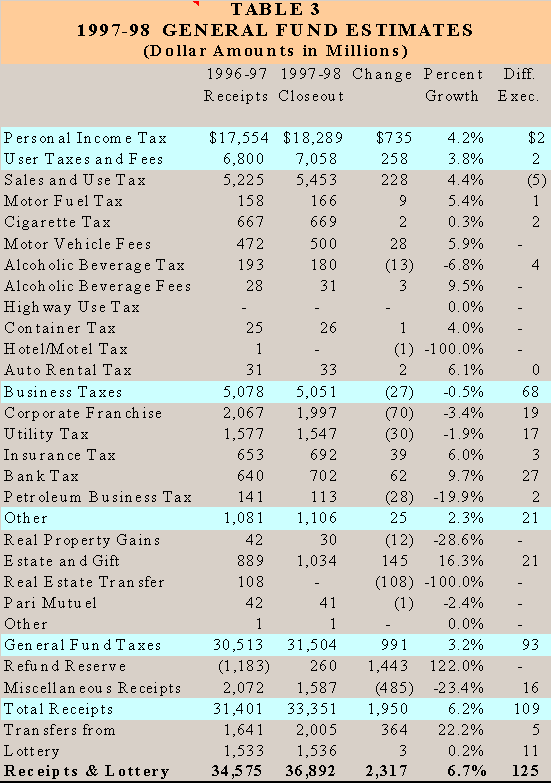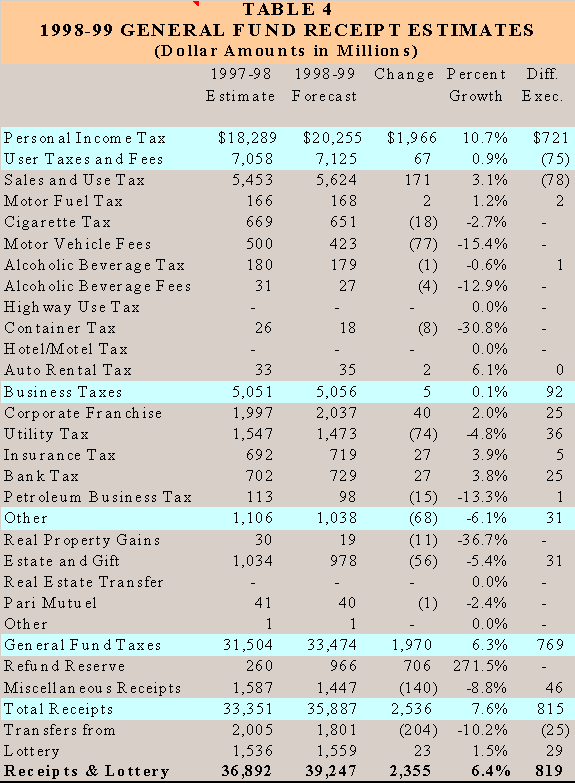Figure 4
Figure 4
Although the Committee Staff estimates General Fund and Lottery receipts growth of 6.7 percent for State Fiscal Year 1996-97 (see Figure 4), General Fund tax growth is estimated to total only 3.2 percent. The growth in General Fund taxes is depressed by more than $2 billion in scheduled tax reductions in various taxes in 1997-98. These reductions are the primary factor holding down receipt growth to only 3.2 percent over last fiscal year. After adjusting for these factors, underlying growth in General Fund taxes is 8.2 percent.
Once again, the Committee Staff forecasts strong capital gains growth, which is reflected in higher Personal Income Tax revenues. The growth in capital gains accounts for the lion’s share of the anticipated growth in the Personal Income Tax. The Committee Staff estimates that Personal Income Tax receipts will grow by $735 million, or 4.2 percent, over State Fiscal Year 1996-97, despite the fact that the final stage of the Personal Income Tax reduction program took effect this year.
User Taxes and Fees are projected to increase by 3.8 percent, or $258 million, over the previous fiscal year. The strength of Sales Tax growth, coupled with slight increases in the Motor Fuel Tax, Auto Rental Tax, and Cigarette and Tobacco Taxes will more than offset declines in other User Taxes such as the Alcoholic Beverage and Container Taxes. A decline in the consumption of distilled spirits has aided the reduction in the Alcohol Beverage Tax.
The strength in Sales Tax receipts is largely the result of the economy’s seven-year expansion. High levels of consumer confidence and growth in employment will result in 4.4 percent growth in Sales Tax revenues. The Committee Staff estimate takes into account strong year-to-date growth in receipts, with continued, but moderated, strength in durable goods orders and retail sales, and economic factors such as high levels of consumer confidence and strong employment and wage growth.
The Committee Staff estimates a decline in the volatile Business Taxes overall, although corporate profits are expected to remain strong throughout the remainder of the fiscal year. The decline in receipts from the prior fiscal year is largely the result of the repeal of the last segment of the Business Tax Surcharge that was enacted earlier in the decade. In addition, the decline in Utility Taxes can be attributed to the additional dedication of approximately $70 million from this tax for mass transit purposes. The exceptions to this trend are an estimated increase in the Insurance Tax and the Bank Tax. Insurance Tax revenues are now projected to increase 6.0 percent over State Fiscal Year 1996-97 collections. Insurance companies are significant long-term institutional investors. As such, much of the growth in Insurance Tax receipts is attributable to gains in investment income. Bank Tax revenues are estimated to increase by $62 million or 9.7 percent over last fiscal year. This is predominantly the result of increased bank profits and the presence of a significant number of consolidations and mergers.
Other Taxes within the General Fund are estimated to increase despite the full dedication of Real Estate Transfer Tax revenues in State Fiscal Year 1997-98, and the repeal of the Real Property Gains Tax in 1996. The increase can be attributed to an substantial increase in Estate and Gift Tax revenues in State Fiscal Year 1997-98, which have been bolstered by an unanticipated increase in large estate payments in the first half of the fiscal year, and the strong valuation of common stocks.
Lottery receipts are estimated to remain at the same level, representing no growth over State Fiscal Year 1996-97. The limited number of large Lotto jackpots in the current fiscal year compared to last year, as well the deterioration of Instant Game sales, have depressed Lottery receipts.
The Committee Staff estimate for General Fund and Lottery receipts for State Fiscal Year 1997-98 is $125 million higher than the Executive. Much of this difference is attributable to the Business Taxes and the Estate and Gift Taxes, in which the Committee Staff predicts revenues of $68 million and $21 million, respectively, above the Executive’s estimates.

The Committee Staff forecast for State Fiscal Year 1998-99 is $819 million higher than the Executive. The majority of this difference, $721 million, falls within the Personal Income Tax. This is the result of the Committee Staff forecast for stronger wage and capital gains growth than that of the Executive.
The majority of the growth in State Fiscal Year 1998-99 revenue lies within the Personal Income Tax. The Committee Staff forecasts that Personal Income Tax receipts will be $1,966, or 10.7 percent, higher than State Fiscal Year 1997-98.
There are three main factors driving this growth. The Committee Staff estimates wages will grow by 5.8 percent in State Fiscal Year 1998-99. This growth encompasses the belief that growth in bonus payments will continue and will reach 10.2 percent in the next fiscal year.
Another factor tied to the growth in Personal Income Tax receipts is capital gains realizations. The Committee Staff forecasts growth in capital gains to equal 18.1 percent. This will result in growth in estimated payments of approximately 11.1 percent. The continuance of overall steady Wall Street activity will aid the growth in estimated payments. The continued growth in capital gains is the result of another successful year on Wall Street as the result of continuing high levels of merger and acquisition activity. Finally, capital gains realizations will continue to benefit from the Federal rate reduction enacted in 1997.
The upcoming fiscal year also marks the first year that no additional tax reductions will occur under the Personal Income Tax. In past years, the growth in the economy allowed receipts to overcome an annual tax reduction in excess of $1.5 billion. This year, receipts are bolstered by a similar amount, absent another tax reduction.
The Committee Staff forecasts growth in the User Taxes to remain fairly flat at 0.9 percent. The largest component of the User Taxes is the Sales Tax, which is forecast to grow by $171 million , or 3.1 percent. This growth rate somewhat lower than the estimated 4.4 percent growth in receipts in State Fiscal Year 1997-98, since it takes into account the slower forecast of employment growth of 1.1 percent for State Fiscal Year 1998-99.
Contributing to the small growth in User Taxes and Fees are estimated declines in the Cigarette and Alcoholic Beverage Taxes. Consumption trends have been steadily declining in recent years, which has led to a steady decline in these taxes. Another factor holding down growth is the Executive’s proposal to reduce passenger car registration fees by 25 percent. This will have the effect of reducing General Fund Motor Vehicle Fees by $49.0 million.
The Committee Staff outlook for Business Taxes in State Fiscal Year 1998-99 varies dramatically among the various individual components. In total, Business Taxes are forecast to show no growth. This is mainly the result of the rate reduction in the Corporate Utility Tax, which is scheduled to begin on October 1, 1998, and the newly created Power for Jobs Program. These two reductions are estimated to reduce receipts by over $80 million in State Fiscal Year 1998-99.
Other Business Taxes are forecast to show positive growth in State Fiscal Year 1998-99. Growth in corporate profits of 6.2 percent, in part due to continued strength on Wall Street will result in an increase of $40 million, or 2.0 percent, in the Corporate Franchise Tax. Insurance Tax receipts will benefit from continued growth in premiums and investment income, and are forecast to increase by $27 million, or 3.9 percent, over State Fiscal Year 1997-98. Finally, Bank Tax receipts are forecast to show continued growth of 3.8 percent as a result of growth in bank profits in general.
The largest decline in General Fund taxes is expected in the Other Taxes. Two areas will contribute to the decline of 6.1 percent over State Fiscal Year 1997-98. Receipts from the Real Property Gains Tax are expected to continue their decline, since the tax was repealed in June 1996. Modest revenues are expected over the next few years in the form of installment payments. Estate and Gift Tax receipts are forecast to decline by $56 million, or 5.4 percent. This decline is mainly attributable to the receipt of several large Estate Tax payments received in State Fiscal Year 1997-98, which are not expected to re-occur.
Other General Fund receipts, which are forecast to vary substantially from State Fiscal Year 1997-98, are Miscellaneous Receipts and Transfers From. Miscellaneous Receipts are expected to decline by $140 million, or 8.8 percent. This is due to the phased-in reduction in Provider Assessments over a five-year period. The reduction in the Provider Assessment Rate will reduce receipts by approximately $40 million in State Fiscal Year 1998-99. In addition, one-time payments of approximately $55 million in retroactive assessments are not expected to re-occur in the next fiscal year.
In State Fiscal Year 1998-99, the large decline in Transfers From is the result of $200 million in Federal reimbursements for prior years’ social service spending in State Fiscal Year 1997-98 not taking place in State Fiscal Year 1998-99. Transfers From Other Funds are expected to decline by $204 million, or 10.2 percent.
